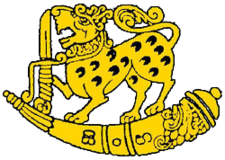Later in the year the Battalion received a batch of 50 recruits trained at the ATC bringing the strength of the Regiment to 19 officers and 615 men. In August 1960, 2nd Lieutenant G Darmaratnam joined the Battalion. He left the Regiment having reached the rank of Captain.
Once again, on 6thSeptember 1960 the officers and other ranks were deployed to the Thodaweli Camp in Mannar to be engaged with the Task Force, Anti Illicit Immigration (TaFII) to prevent illegal immigrants from India sneaking into Mannar by crossing the sea across the Palk Strait. In addition the troops were also required to lookout for smugglers. By the end of 1960 the troops were successful in apprehending 56 illegal immigrants.
The Battalions 4th Anniversary was celebrated in Diyatalawa where religious activity making it the first time a Battalion celebrated their Regimental Day giving priority to religious activity. Buddhist monks arrived at the Diyatalawa Camp in procession and chanted pirith throughout the night. Alms were offered to the Maha Sangha the following day.
On 4thFebruary 1961 for the Independence Day Parade was held in Kandy marking it as the first time the Parade was held outside Colombo. The appearance of 'Tojo', the Saanan goat, mascot of the Battalion, marched with the Sinha contingent of this parade. This was the first time in the history of the Ceylon Army where a mascot took part in a parade.
In December 1961, 2nd Lieutenant OV Wijesekara joined the Battalion having completed his Officer Cadet Training at the Royal Military Academy (RMA), Sandhurst, UK.
The failed coup plotted by some army and police officers to overthrow the government in 1962 created considerable concern in the Army. As details of the plans unfolded more and more senior officers were arrested and pending trial, kept in custody at the Magazine Prison, Welikada. Troops from Sinha and other Battalions, handpicked for the purpose were employed to guard the suspects. Similarly, troops of the Ceylon Sinha Regiment were handpicked and detailed for guard duties at the Queen's House (the Governor General's residence) and the Prime Minister's residence (the Temple Trees). Known as the Composite Guard these troops were stationed at the Echelon Square, Colombo. The hand picking of troops for Composite Guard duties as well as for other duties mentioned, for the first time feelings of mutual mistrust, suspicion and discrimination surfaced within the Battalion and later elsewhere in the Army.
In June 1962, saw the retirement from the Army of one of its World War II veterans and a reputed instructor Warrant Officer II Seneviratne Q. Widely known as 'Quintus', he prior to retirement served the Regiment as a CSM for five years.
In July 1962, the Battalion under took the training of 60 recruits who were eventually posted to the Regiment. At their passing out parade, Sinha created history again when the recruits with a mere three months training, paraded in slow, quick and double quick time and to cap it all, performed arms drill to music. Together with this batch, the Battalion received 68 recruits from the ATC. Hence, the Battalion had to conduct post-depot training for approximately 130 soldiers. During the same period the Regiment was called up to perform another training assignment which was the training of 70 Officer Cadets for the Volunteer Force. This was the largest ever course of training held in Ceylon for would be officers at that time.
In August 1962, 2nd Lieutenant GH de Silva and in December 1962, 2nd Lieutenant ARP Wijeratne joined the Battalion after passing out from the Royal Military Academy, Sandhurst, UK. Later the former was transferred to the 1st Battalion Gemunu Watch and eventually became the Commander of the Army in the rank of Lieutenant General.
In May 1962, 106 soldiers who had completed their basic training at the Recruit Training Centre at Diyatalawa joined the ranks of the Sinha Regiment while in July 1963 a batch of 68 soldiers did the same.
In 1962, The Corps of Infantry was established as part of the Regular Force of the Sri Lanka Army. Comprising the 1st Battalion Ceylon Light Infantry, the 1st Battalion Sri Lanka Sinha Regiment and the 1st Battalion Gemunu Watch, this provided a common list for inter-battalion transfers. Consequent to these transfers officers were shuffled within the said Battalions. From the 1st Battalion Ceylon Light Infantry Lieutenant Colonel LHD de Silva, Major CC Labroy, Captain KJTN Goonawardane, Captain N Amirthalingam, Captain SB Miyanadeniya, Captain EEP Joseph were transferred to the 1st Battalion Ceylon Sinha Regiment. Similarly, Major FB de S Sri Ananda, Major TSB Sally, Captain DA Wickramasinghe, Captain A Ariyapperuma, Captain TRT Jayatunga, Captain W Halangoda, Lieutenant LT Fernanado, Lieutenant PW Fernando and 2nd Lieutenant GH de Silva were transferred from the 1st Battalion Sinha Regiment to the 1st Battalion Gemunu Watch. Subsequently, Captain PPCC Cooray and Captain LA Balthazar too were subjected to transfers and Captain VC Adhihetti joined Sri Lanka Army Ordnance Corps.
In August 1963, 2nd Lieutenant DA Arthanayake joined the Battalion having completed his officer cadet training at the Royal Military Academy, Sandhurst, UK while 2nd Lieutenant PCR de Silva, 2nd Lieutenant RWW Ranawana and 2nd Lieutenant VD Lankatilake joined the Battalion in December 1963 having completed the Young Officers' Training Course at Army Training Centre, Diyatalawa. Of these officers, the latter two were promoted to the Rank of Major Generaleral at the time of their retirement.





